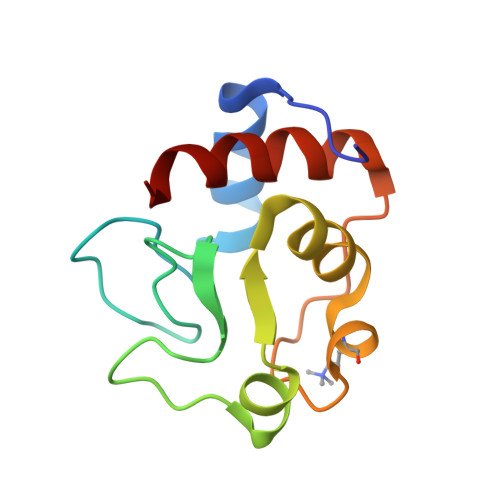Mutation of tyrosine-67 to phenylalanine in cytochrome c significantly alters the local heme environment.
Berghuis, A.M., Guillemette, J.G., Smith, M., Brayer, G.D.(1994) J Mol Biol 235: 1326-1341
- PubMed: 8308895
- DOI: https://doi.org/10.1006/jmbi.1994.1086
- Primary Citation of Related Structures:
1CTY, 1CTZ - PubMed Abstract:
The high resolution three-dimensional atomic structures of the reduced and oxidized states of the Y67F variant of yeast iso-1-cytochrome c have been completed. The conformational differences observed are localized directly in the mutation site and in the region about the pyrrole A propionate. Shifts in atomic positions are largely restricted to nearby amino acid side-chains, whereas little perturbation of the polypeptide chain backbone is observed. One prominent difference between the variant and wild-type structures involves a substantial increase in the size of an already existing internal cavity adjacent to residue 67. This same cavity contains an internally bound water molecule (Wat166), which is found in all eukaryotic cytochromes c for which structures are available. In the reduced Y67F mutant protein a second water molecule (Wat300) is observed to reside in this enlarged internal cavity, assuming a position approximately equivalent to that of the hydroxyl group of Tyr67 in the wild-type protein. A further consequence of this mutation is the alteration of the hydrogen bond network between Tyr67, Wat166 and other nearby residues. This appears to be responsible for the absence of oxidation state dependent changes in polypeptide chain flexibility observed in the wild-type protein. Furthermore, loss of the normally resident Tyr67 OH to Met80 SD hydrogen bond leads to a significantly lower midpoint reduction potential. These results reaffirm proposals that both Tyr67 and Wat166 play a central role in stabilizing the alternative oxidation states of cytochrome c.
Organizational Affiliation:
Department of Biochemistry, University of British Columbia, Vancouver, Canada.

















